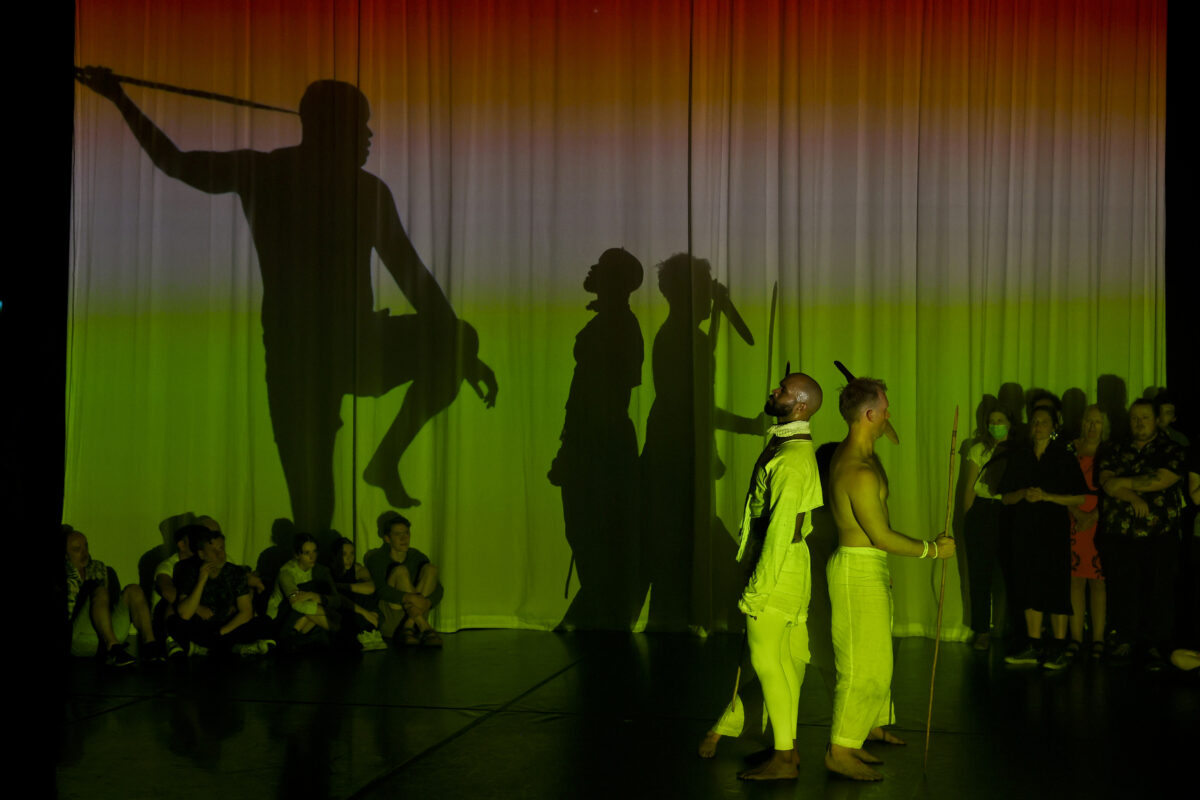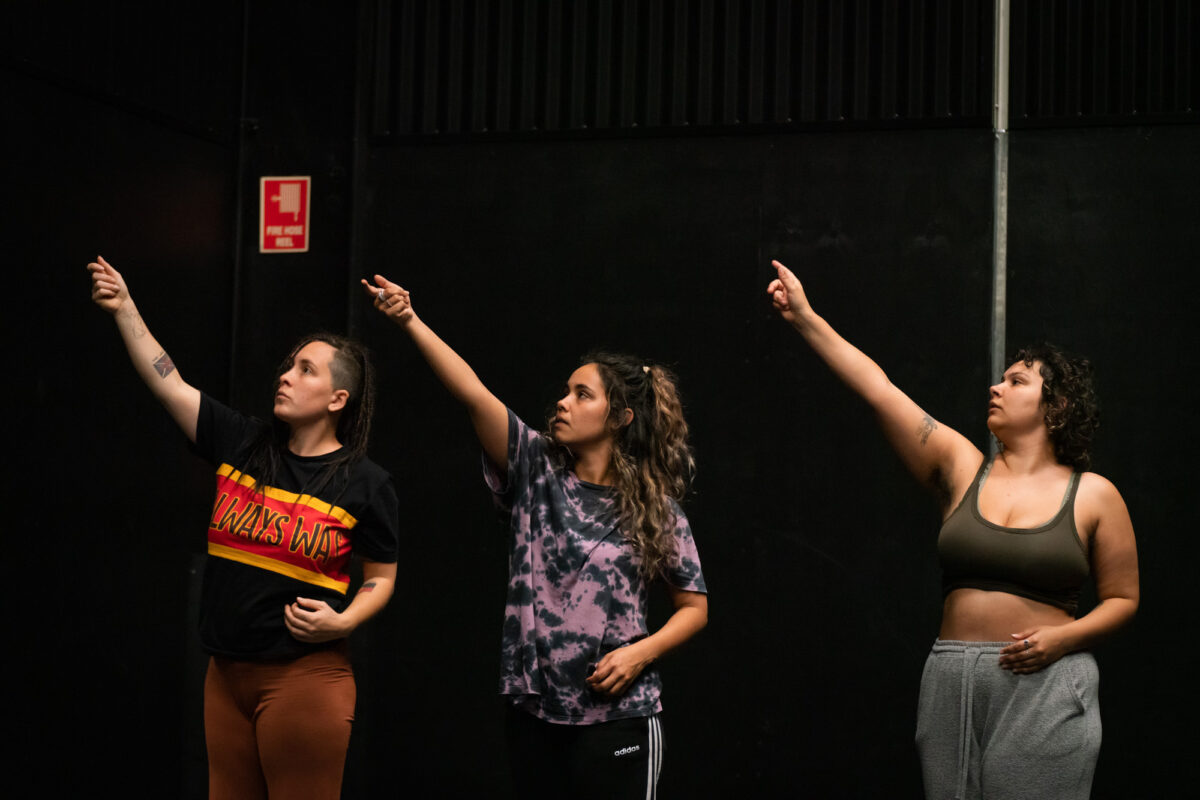
Merindah Donnelly is a mother, partner and proud Wiradjuri woman, living in Meanjin, Queensland as a guest on Turrbul and Yuggera homelands. She is currently the co-CEO and Executive Producer at BlakDance. Merindah has previously worked in Market Development at the Australia Council for the Arts and as producer for major Australian Indigenous self determined performance gatherings in both theatre and dance. Merindah sat on the First Nations advisory group for Australian Performing Arts Market, has been a curator at Brisbane Festival and is part of Global First Nations networks. She is an International Society of Performing Arts (ISPA) Fellow and has completed a Masters in Cultural Leadership at National Institute of Dramatic Arts (NIDA).
In this dialogue with Tiwi Producer, Libby Collins, Merindah connects the idea of self-determination with creating pathways from education into employment for First Nations practitioners, as well as honing local creative control. She talks Indigenous Cultural Intellectual Property, asserting cultural governance to navigate – and subvert – Western legal systems, cultural safety at policy levels, and more.
When you develop or engage with First Nations content, what do you consider ‘best practice’?
BlakDance is a self determined service organisation and Producer, we’re here to serve First Nations dance artists and transform the arts ecology they are a part of. In this context what we strive to uphold is self-determination in the creation and distribution process, as well as the artistic vision.
I think that’s really important because so many artists want full self determination across the production of their work, including where it is going to be presented or where it’s going to tour. But with a dearth of independent First Nations producers this kind of access to ‘self-determined distribution’ can be hard to find.
We’re talking about proper self-determination across the production value chain, as well as the self-determination of the artistic vision; we’re talking about an ecology the artistic vision sits within, and ensuring all of the hands that touch the work are blak hands (to quote Daniel Riley, Artistic Director Australian Dance Theatre) – from the lighting designer through to the production manager through to the set designer, sound designer, choreographer, director, producer, dancers. In our community, there are so few blak lighting designers and so few blak production managers etc. which means we can’t meet the demand to work in this way for all the exciting blak artists making work, and it doesn’t scale, which holds back opportunities for our artists.
As a service organisation, what we have to do is ask ourselves, ‘How do we create the environment where there’s enough blak productions managers, lighting designers, costume designers, producers and blak creative collaborators on a project?’
That requires service organisations like BlakDance to have a helicopter overview of what’s going on in the sector, what is the health of our ecology defined through our terms of reference. We have to look at things like pathways into employment from university or training institutes, like NAISDA, ACPA or VCA etc. We have to collaborate with our sector to imagine a ten year plan for workforce development. We’re also thinking about wellbeing and how we make sure that our Blak values are at the forefront of how we operate as an organisation and support artists. For example, we’ve just had a show that we’ve been touring called Silence by Karul Projects. Karul Projects is a new First Nations professional contemporary dance company on the Gold Coast run by Thomas E Kelly and Taree Sainsbury who have just had a baby. So for Silence to go on the road – because culture and family come first – we have to build extra considerations into the funding applications for childcare. Because blak artists with young families should be able to go on tour and be a part of the show and take their babies with them on the road. The same thing applies to our staff as well.
Then another area of best practice is the way we work with artists who come to us with a specific idea or artistic vision for a new work. As producers, we will work with them to ensure the documentation process of permissions, protocol agreements and different types of tools that we have for bringing in family and community as collaborators while making sure that everyone has free and prior-informed consent and understanding around what the project is. This is a decade’s worth of work that we’ve invested in upholding Indigenous Cultural Intellectual Property (ICIP) and protocols and appropriate use and permissions for the creation of new contemporary dance works. We’ve worked with Terri Janke & Associates on the legal side of our agreements. We’ve piloted the actual tools that we use to document and record the process of permissions and protocols on a number of projects. It’s not perfect, but we continue to refine our processes and methodologies to ensure cultural equity in the artists’ projects we have the capacity to support.

Garabari by Joel Bray Dance and Chunky Move, image by Jeff Busby
Can you tell me more about the cultural governance systems that operate within Blak Dance?
We’re a blak company that’s set up in a western legal system for corporations as a result of colonisation. We have a First Nations-led Board of directors who comply with the requirements of a company limited by guarantee. Like all Boards they’re responsible for the governance, for risk and strategic oversight – but what we also have is cultural governance.
Initially, Blak Dance had a cultural advisory group and then we had an Elders group and then we more recently have evolved the Cultural Council. Its members have to be Indigenous and have experience in dance; generally we’re probably talking about more senior people, their role is to provide strong cultural guidance. For example, when we go on tour, there’s protocols for how that touring company goes into each community and the way that we engage with the community and are welcomed on Country and the response from the touring party, what sort of thing might happen at the venue where they’re going to do a performance, such as a smoking ceremony. The Cultural Council advises on and informs these processes, and they can guide us not only on how we support artists but how we ensure cultural safety is honoured when we partner or collaborate with non-Indigenous organisations.
A lot of First Nations artists just want to be able to access the tools we’ve developed and the agreements and the contracts. Then independent artists are doing their own projects, it’s a lot to develop all that paperwork and work through the detail of how to actually enact those cultural protocols in a legal and cultural process. We’re really excited to be able to share that with independent artists. That’s really what contributes to creating cultural safety and upholding our cultural rights.
In terms of setting up that governance structure within Blak Dance and having that resource for artists, could you talk about the value of that and what that offers even non-Indigenous organisations trying to work with blak artists?
We’re a tight, nimble, team of seven and we’re all part-time. If we want national reach we have to work in partnership with organisations across the sector. Unfortunately, it is not an option for us to only partner with self-determined First Nations organisations simply because there are not enough of us yet. This is a reason why part of our mandate at BlakDance is to proactively incubate and support emerging self determined First Nations companies like Karul Projects and Gary Lang NT Dance Company. Until then it is necessary that we work across the sector with non-Indigenous organisations to clear the ground for First Nations dance to occur.
We generally do not commence a partnership with a non-Indigenous organisation until they have completed a cultural equity assessment internally with their board and their staff. We give them this questionnaire around things like policy, governance, budget, program, employment, and they bring it back to us and we go through it together and it becomes very obvious straight away if there are concerns around cultural safety or equity that have to be addressed before we can collaborate..
Sometimes our partners have to go away and do more work with their local community and local cultural authority to sort this stuff out and they’ve got to consult with them and then come back and tell us what’s up. We’ve done this now with probably 12 organisations and we’re seeing those organisations change and address structural racism.
We’re seeing them properly consult and create and facilitate local self-determination. So local creative control over what programs are there for their local community can happen. I mean, it’s not rocket science, but it’s good because now we can partner with them because we know that the community is behind it, so it’s hopefully a culturally safe partnership.
Do you think more organisations will move toward having a cultural safety structure in place the way that Blak Dance does?
I think that organisations are desperately trying to figure out how to do that, a critical mass committed to this now – we’ve reached a tipping point. But there are unaddressed problems at a policy level.
In some places we can see the government focus on cultural engagement only being funded through the non-Indigenous organisations and institutions, which can have negative unintended consequences for blak organisations.
I come from being trained up by strong blak women who fought for self-determination. Who fought for blak companies, who fought for our self-determined industry, and whose Elders gave them this responsibility, so I’m proud to be a part of a legacy of strong blak performing arts leaders who’ve fought for self-determination and I take it very seriously.
The baton that’s been handed to me in my role at BlakDance is continuing that fight but that fight gets overshadowed when the focus becomes how white organisations can do blak stuff better.
Unless there is an equal or larger emphasis on how to support First Nations Leadership, First Nations creative control, First Nations self-determination then that important work that needs to happen in those non-indigenous organisations is at risk of taking over the self-determined industry.
The UN’s Declaration on the Rights of Indigenous People talks about how Indigenous peoples have the right to participate in our own cultural expression and artistic forms, and that we dictate as well as participate in our cultural expression and forms. So that’s where I go “Let’s not get distracted from our own self-determination by trying to ensure that non-Indigenous organisations are doing cultural engagement better.”
They got to do that. But we also have our own thing and that’s a human right and we can live in a world where both of those things coexist.

Charcoal by Keia Mcgrady, image by Jade Ellis Photography
Project led by:

Supported by:

In partnership with:
![]()
